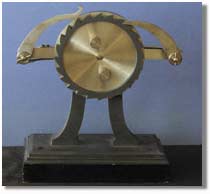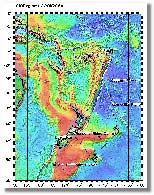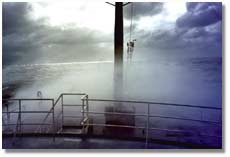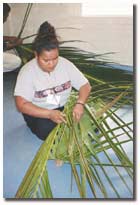| |
***SPECIAL EDITION***
October 8, 2003
Discover the Physical World Through the National Science Digital Library
The National Science Digital Library (NSDL) is building the collections and services of an online digital library for science, technology, engineering and mathematics education for all ages. Supported by the National Science Foundation (NSF), the NSDL provides access to materials and methods that reveal the nature of the physical universe and a way for humans to discover and understand it.
The collections described here represent only a few of the collections currently accessible or being brought online through the main NSDL portal. NSDL collections and research activities will be on display at the NSDL annual meeting being held October 12-15 in Washington, D.C. For more information on NSDL or these collections, contact David Hart at (703) 292-7737 or dhart@nsf.gov.
National Science Digital Library: www.nsdl.org
NSF Program Officer for NSDL: Lee Zia, (703) 292-5140, lzia@nsf.gov
Images available at http://www.nsf.gov/od/lpa/news/media/newstips.htm
|
BONES OF CONTENTION: HUMANS AND PRIMATES -- The eSkeletons project at The University of Texas at Austin lets students and teachers view and compare the bones of a human, gorilla, baboon as well as other species and gather information about them from the Texas anthropology department’s osteology database. In addition to high-quality, close-up images of bones and labels for each bone’s key anatomical features, the eSkeletons site lets visitors examine the bones through high-resolution 3-D animations and as interactive virtual reality objects. The eSkeletons site will soon be making bone data available in a format from which visitors can create 3-D replicas of the bones (with appropriate equipment).
eSkeletons project: www.eskeletons.org
|
 |

The eSkeletons digital library lets students examine and compare the skeletons of a human, gorilla, baboon and other species through high-resolution annotated photos and 3-D digital models. The collection will soon provide data in a format that will allow users to build replicas of the bones. This image shows a baboon skull with the frontal bone highlighted and a 3-D model of the skull.
Credit: eSkeletons Project, University of Texas, Austin
Select image for larger version
(Size: 61KB)
, or download a high-resolution
TIFF version of image (2.02MB)
|
 |
WIRED FOR ANIMAL SOUNDS -- The sounds of Psittacidae, the parrot family, are among the thousands of animals whose sounds have been recorded and stored in the Macaulay Library at the Cornell Lab of Ornithology. The Macaulay Library houses the world's largest collection of video and sound recordings of animal behavior, and a new NSDL project is supporting the library in its efforts to make its archive available online for research, education and conservation uses. The Macaulay Library currently holds over 160,000 sound recordings from not only 136 species of hawks and eagles, more than 40 species of hummingbirds and 180 species of woodpeckers (including the extinct ivory-billed woodpecker) and other birds, but also many other animal groups such as whales and dolphins (through a $2 million grant from the Office of Naval Research), insects, New World mammals and frogs. In addition, the library will soon archive a diverse collection of the communication signals used by electric fish. The Macaulay Library is building a parallel library of videos of animal behavior and currently has material on over 2,500 species of birds. All of this, along with annotations on content, will be made available through the new NSDL portal to the Macaulay Library.
Macaulay Library of Natural Sounds: www.birds.cornell.edu/lns
|
MECHANICAL MODELS IN MOTION -- Cornell University holds the world’s most complete collection of model machines designed by German engineering professor Franz Reuleaux (1829-1905). Reuleaux, the founder of modern kinematics and a forerunner of modern design theory of machines, created the machines to teach kinematic principles. The Kinematic Models for Design Digital Library (K-MODDL) will be a collection of digital images, movies and interactive models centered around these 220 rare 19th-century mechanical models. Over time, the project intends to have other models from all over the world added virtually to the collection. Simulations of the models' movements, related full-text documents and sample classroom teaching modules are planned for the collection. The K-MODDL team of librarians and mechanical engineering and mathematics professors is also developing a method that allows the machines to be "printed out" into working plastic models—a preview of future digital libraries that may allow users to access a hand-held replica of cataloged objects.
K-MODDL: kmoddl.library.cornell.edu
|
 |

Select image for larger version
(Size: 74KB)

Select image for larger version
(Size: 42KB)

In the 1800s, German engineering professor Franz Reuleaux designed hundreds of devices to teach the principles of kinematics. These photos show an original Rouleaux model of a ratchet mechanism (1882) in the Cornell Collection of Reuleaux Kinematic Models, a 3-D computer-aided design representation of the original, and a 3-D model (2003) "printed" with rapid prototyping technology. Cornell University is creating the Kinematic Models for Design Digital Library (K-MODDL) to let students and teachers see, interact with and even replicate more than 200 of these rare Reuleaux devices. From a preprint, "3-D Printing the History of Mechanisms" (2003), H. Lipson, F.C. Moon, J. Hai and C. Paventi, Cornell University Sibley School of Mechanical Engineering.
Credit: F.C. Moon, Cornell University
Select image for larger version
(Size: 27KB)
|
 |
EXPLORATORIUM ONLINE -- San Francisco’s Exploratorium, the hands-on science museum for all ages established in 1969, is developing Exploratorium Online, a digital collection of teacher-tested resources from the museum's 650 interactive exhibits. These exhibits cover topics ranging from the science of eggs to weight on other planets The NSDL collection will enhance the information on the Exploratorium’s extensive Web site (established in 1993) by providing access in a uniform, searchable database coordinated with curricular standards. The project is also creating guidelines for cataloging digital exhibit-based science resources that capture the unique museum quality and maximize the teaching value of Exploratorium digital assets.
Exploratorium: www.exploratorium.edu
|
A CENTURY OF OCEAN EXPLORATION -- Not everyone can ride a research vessel through stormy seas from New Zealand to Samoa to map the ocean floor. To bring the human side of oceanography to life for students and others, the Scripps Institution of Oceanography (SIO), the San Diego Supercomputer Center and the University of California, San Diego, Libraries are creating SIO Explorer, an oceanography digital library that combines materials from the SIO Library Archives, data from the SIO Geologic Data Center, published research papers and historic documents from SIO’s 100 years of ocean-going voyages. Each modern cruise results in nearly a thousand digital objects. SIO is one of four key institutions that pieced together the concepts of plate tectonics in the 1960s, and SIO Explorer will be a data-oriented collection for plate tectonics education. Items in the collection are being linked to historic and modern marine geological and geophysical data via information technology tools that "bridge the gap" between science data archives and libraries.
SIO Explorer: nsdl.sdsc.edu
|
 |

A prototype SIOExplorer Digital Library system was tested on board the R/V Melville of the Scripps Institution of Oceanography (SIO), during the Cook Expedition, Leg 20, from New Zealand to Samoa. Shipboard data streams were automatically prepared for online search across the web as a part of the National Science Digital Library. The SeaBeam sonar on the R/V Melville maps a swath of the seafloor approximately 20 km wide in deep water, creating real-time contour maps of ocean depth. The result of the cruise was approximately 10 GB of new digital data, ready for search along with the evolving SIOExplorer collection of data, documention, reports, images, sampling information and publications from 721 SIO cruises since 1950.
Credit: SIOExplorer Digital Library Project, Geological Data Center, Scripps Institution of Oceanography, UCSD
Select image for larger version
(Size: 12KB)

The seas south of New Zealand are known to get rough due to constant Antarctic storms. This photo was taken on board the R/V Melville of the Scripps Institution of Oceanography during the Cook Expedition, Leg 20, from New Zealand to Samoa. The ship was at around 50 degrees south latitude, also known as the "ferocious fifties."
Credit: Dru Clark, Geological Data Center, SIO, UCSD
Select image for larger version
(Size: 27KB)
|
 |
|
THE GLOBAL CULTURES OF MATHEMATICS -- The Yup’ik people of Alaska count in a number system based on 20s, as did the Mayans of Central America. The Chuukese people of Micronesia have different words for counting objects depending on whether the objects are flat, long, solid or layered. The ancient Incans counted with quipus, strings with knots tied in them. Ethnomathematics is the study of how every culture’s unique approach to mathematics is reflected in its language and daily life, and the Ethnomathematics Digital Library is a collection of articles describing the mathematics of cultures from the Aborigines in Australia to the Shona people of Zimbabwe. The EDL, being created by a network of institutions led by Pacific Resources for Education and Learning, has the potential to foster the creation of classroom materials that acknowledge and build on these cultural foundations.
Ethnomathematics Digital Library: www.ethnomath.org
|
 |

A participant at the Pacific Educational Conference in Pohnpei, the largest island in the Federated States of Micronesia, undertakes an activity on weaving and symmetry available through the Ethnomathematics Digital Library.
Credit: Nancy Lane, PREL
Select image for larger version
(Size: 66KB)
Larger versions
(Total Size: 309KB)
of all images from this document
 Note
About Images Note
About Images
|
 |
FROM FRANKLIN’S STOVE TO A SCANNING ELECTRON MICROSCOPE -- The Innovation Curriculum Online Network (ICON) provides a central source that helps teachers find Web-based classroom activities dealing with technology and innovation and its impact on the human built world, history, and society. The activities, searchable by topic and by grade level, range from a kindergarten connect-the-dots puzzle of Ben Franklin's stove to a virtual scanning electron microscope for a high school science class. The International Technology Education Association and The Eisenhower National Clearinghouse have created ICON for K-12 teachers and college and university faculty to find information and classroom activities that increase students' technological literacy.
ICON: icontechlit.enc.org
Top of Page
|
|








